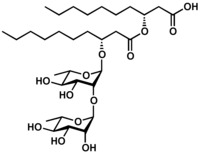
Photo from wikipedia
Curvularia lunata (Wakker) Boed, the causal agent of Curvularia leaf spot, is an important fungal pathogen in maize. Iron deficiency or excess plays a crucial role in mycelial growth and… Click to show full abstract
Curvularia lunata (Wakker) Boed, the causal agent of Curvularia leaf spot, is an important fungal pathogen in maize. Iron deficiency or excess plays a crucial role in mycelial growth and virulence of plant pathogenic fungi. In this study, the following pathogenic characteristics of C. lunata under different Fe3+ concentrations were investigated: mycelial growth, conidiation, conidium germination, virulence in maize, toxin and cell wall degrading enzymes (CWDEs) activity. The results showed that iron had a limited impact on the mycelial growth, while it had an obvious impact on mycelial biomass, conidiation, and the conidial germination at a concentration of 40–50 μM Fe3+. Exogenous supplementary of Fe3+ also significantly enhanced the pathogenicity of C. lunata CX-3 strain on maize inbred line Huangzaosi. However, toxin activity was independent of Fe3+ concentration. Exogenous iron application improved polygalacturonase (PG) activity in the early stages of infection, and the activity of cellulase (Cx), pectin polymethyl galacturonase (PMG), polygalacturonic acid transeliminase (PGTE) and pectin methyl transeliminase (PMTE) after 72 h of infection in maize.
Journal Title: European Journal of Plant Pathology
Year Published: 2020
Link to full text (if available)
Share on Social Media: Sign Up to like & get
recommendations!